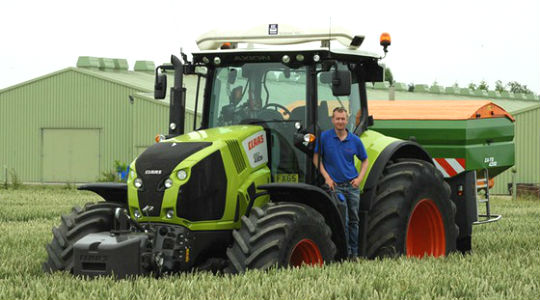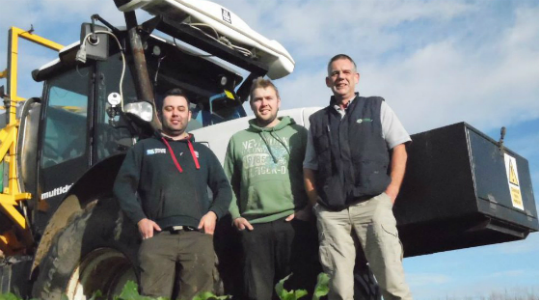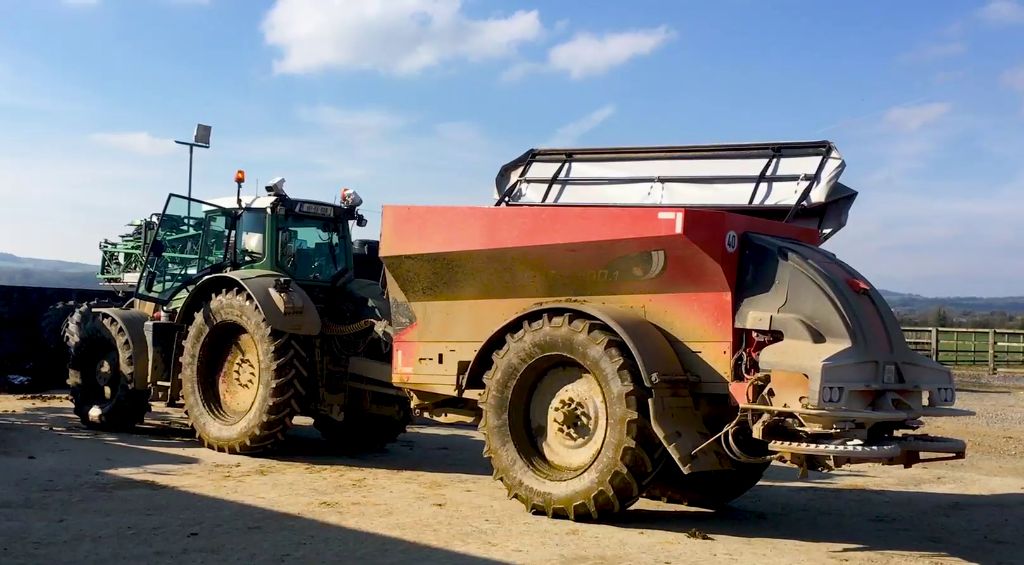Real-time variable rate nitrogen management
-
A tractor-mounted real-time variable-rate nitrogen sensor
-
Measures crop nitrogen requirement as the fertiliser spreader passes across the field
-
Variably adjusts the fertiliser application rate in real-time
N-Sensor: tractor-mounted remote sensing
Site-specific fertilisation is one of the main objectives of precision agriculture. Variable-rate nitrogen application requires accurate and efficient tools to determine the actual crops nitrogen status. Remote sensing techniques offer the opportunity to deliver this information quickly, precisely and cost-efficiently. The N-Sensor has been developed to determine the crop nitrogen status by measuring the light reflectance properties of crop canopies and to enable variable-rate fertilisation “on-the-go”.
What do farmers say about the N-Sensor
Benefits of the N-Sensor ALS 2
Agronomic
- Unique agronomically based, crop (wheat, oilseed, barley, maize) specific algorithms
- Unique spectral indices to accurately ‘sense’ variable nitrogen supply throughout the main growing season.
- Clean, accurate ‘sensing’ with NO clouds, trees, landscape features to corrupt the data
- Unlimited scanning, day or night, NO waiting for satellites.
- Large ‘scanning footprint’ – up to 4.2m width each side of the sensor
- 4 wavelengths measured giving enhanced accuracy, suppressing the effects of damp leaves (e.g. dew)
- Apply the optimal nitrogen fertiliser rate to every part of the field
- Maximise the crop’s potential across the whole field
- Increased yields and improved grain quality from more homogeneous crops
- Improved combine performance, reducing harvesting time and cost through more uniform crops
Environmental
- Increase nitrogen use efficiency, reducing the risk of nitrogen losses to the environment
- Decrease nitrogen residues in soils post-harvest
- Reduces carbon footprints
Practical
- Variable nitrogen applications from simple ‘switch on and go’, to more complex precision mapping and data management.
- Lightweight for easier, safer fitting.
- Modular design for more flexibility in fitting
- LAN connections enable greater distances between sensor heads when mounting.
How does N-Sensor work?
The N-Sensor determines the nitrogen demand by measuring the crop’s light reflectance covering a total area of approximately 50m2 / sec. Measurements are taken every second with the system designed to operate at normal working speeds and all bout widths. Most sensing technology applied to agriculture is based on the typical light reflectance curve for vegetation (NDVI). N-Sensor measures light reflectance at specific wavebands related to the crop’s chlorophyll content and biomass.
It calculates the actual N-uptake of the crop. Optimum application rates are derived from the N-uptake data and sent to the controller of the variable rate spreader or sprayer, which will adjust fertiliser rates accordingly.
The whole process of determining the crop’s nitrogen requirement and application of the correct fertiliser rate happens instantaneously, with no time delay. This enables “real-time agronomy and application” to be possible.
N-Sensor development
Following development coordinated by Yara’s Research and Development Centre, Hanninghof in Germany, the first N-Sensor (Classic) was introduced in 1999 for use on cereals.
Work to develop the N-Sensor to keep up with changes in cereal production as well as for use on a wider range of crops and has been a continuous part of Yara’s R&D Programme. More than 250 trials have been carried out between 1997 and 2010 to refine its performance and add new programs such as the Absolute-N calibrations for oilseed rape.
History of N-Sensor - two systems, one philosophy
The Yara N-Sensor ALS-2 is the culmination of over 20 years of development work at Hanninghof in Germany, through extensive testing and trial work. Originating from the first generation Passive N-Sensor in 2005 the Active
Light Source (ALS) was introduced as a solution to restricted working hours due to low or no ambient light. As the name suggests the ALS contains its own light source to continue operating irrespective of ambient light conditions.
Development of the ALS-2
In 2018 the ALS 2 was launched. During research and development, Yara had recognised the issue of damp leaves (dew) that affects all sensors and the reflectance accuracy achieved. Research was targeted to overcome this issue, culminating in the requirement to capture extra waveband data during sensing. This ‘dew suppression’ is unique amongst sensors and is a feature in the ALS 2 N Sensor. A new modular design and improved connectivity gives the ALS 2 more flexibility and easier mounting options.
The major difference between the two N-Sensors is that the ALS Sensor has its own built-in light source. Instead of using daylight for the measurement, the N-Sensor ALS is constantly beaming its own source of light at the crop, using Xenon flash lamps, and recording the reflectance. This enables N-Sensor ALS operation independent from ambient light conditions, even at night.
Related tools


























































